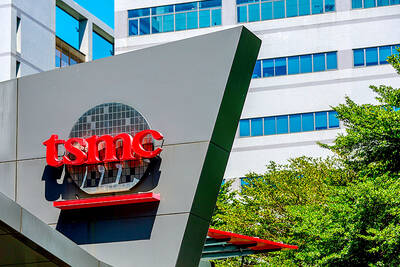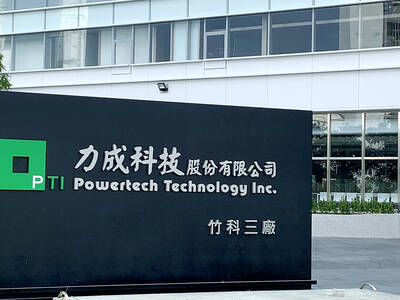Close to a small fishing port in southwestern Japan, the slim white turbines of the country’s first commercial-scale floating wind farm glimmer offshore, months before a key project in Tokyo’s green-energy strategy begins.
Still heavily reliant on imported fossil fuels, Japan has declared offshore wind energy a “trump card” in its drive to make renewables its top power source by 2040, and reach carbon neutrality a decade later.
That is despite rising project costs and fears over inadequate infrastructure to produce turbines en masse. Floating turbines are particularly well suited to Japan as its deep coastal waters make fixing them to seabeds tricky, while the country is also prone to natural disasters.

Photo: AFP
“Floating structures are relatively stable even in the case of earthquakes or typhoons,” said Kei Ushigami, head of marine renewable energy for construction company Toda Corp, a key player in the project.
The eight turbines — sitting 5km off the Goto Islands in waters up to 140m deep — would officially start turning in January next year.
It is hoped they would aid the archipelago in reaching ambitious new targets laid out this year that should see wind’s contribution to the energy mix soar to between four and eight percent by 2040 — up from about 1 percent today.
It is a long, hard road ahead for resource-scarce Japan — the world’s fifth-largest carbon dioxide emitter — to wean itself off fossil fuels.
Last year, 65 percent of its electricity needs were met by coal and hydrocarbon-powered thermal plants, while just more than one- quarter came from renewables, Japan’s Institute for Sustainable Energy Policies.
Costs are also rising sharply, and at the end of last month Japanese conglomerate Mitsubishi Corp pulled out of three key wind power projects deemed no longer profitable. Other project operators have asked for better support from the government.
“It is important for the government to address shortcomings in the current bidding system, which failed to anticipate rapid global inflation after bids were awarded,” said Yoko Mulholland, a senior policy advisor at the think tank E3G.
The streamlining of regulatory processes and easing construction restrictions would “shorten lead times and also lower capital expenditure,” she said.
Hidenori Yonekura, the director of New Energy and Industrial Technology Development Organization’s wind and marine unit, said the nascent floating wind energy is a path to eventually lowering costs, by installing more turbines in Japan’s vast exclusive economic zone of 4.5 million square kilometers.
However, the task appears Herculean: To meet the 2040 wind target, about 200 15-megawatt turbines a year need to go up.
However, “the infrastructure is not yet in place,” Yonekura said. “Japan lacks turbine manufacturers and large production sites.”
Construction companies also face technical challenges with the still-novel systems: Defects discovered in the floating structure of a wind turbine at Goto meant Toda had to make replacements, delaying the project by two years.
Coexistence with local industries, especially fishing, is also crucial.
Toda said it had conducted an environmental assessment and found a pilot project had “no negative impact on fish.”
Fishers also receive part of the revenue from electricity sales and some of the property taxes generated by the project, while some have been hired to monitor the construction site with their vessels.
However, Takuya Eashiro, head of the Fukue fishing cooperative in Goto, the wind project was imposed “from the top” and presented as “a done deal.”
Nevertheless, “fishermen understand the importance of such a project for Japan,” he said.
The National Federation of Fisheries Cooperative Associations protested to the government after Mitsubishi withdrew, reminding them that fishers had worked with the projects, hoping for positive economic impacts.
As fishing becomes less viable due to warming sea temperatures, “some hope their children or grandchildren will find jobs in wind turbine maintenance,” Eashiro said.

Taiwan Semiconductor Manufacturing Co (TSMC, 台積電) has secured three construction permits for its plan to build a state-of-the-art A14 wafer fab in Taichung, and is likely to start construction soon, the Central Taiwan Science Park Bureau said yesterday. Speaking with CNA, Wang Chun-chieh (王俊傑), deputy director general of the science park bureau, said the world’s largest contract chipmaker has received three construction permits — one to build a fab to roll out sophisticated chips, another to build a central utility plant to provide water and electricity for the facility and the other to build three office buildings. With the three permits, TSMC

RUN IT BACK: A succesful first project working with hyperscalers to design chips encouraged MediaTek to start a second project, aiming to hit stride in 2028 MediaTek Inc (聯發科), the world’s biggest smartphone chip supplier, yesterday said it is engaging a second hyperscaler to help design artificial intelligence (AI) accelerators used in data centers following a similar project expected to generate revenue streams soon. The first AI accelerator project is to bring in US$1 billion revenue next year and several billion US dollars more in 2027, MediaTek chief executive officer Rick Tsai (蔡力行) told a virtual investor conference yesterday. The second AI accelerator project is expected to contribute to revenue beginning in 2028, Tsai said. MediaTek yesterday raised its revenue forecast for the global AI accelerator used

The DBS Foundation yesterday announced the launch of two flagship programs, “Silver Motion” and “Happier Caregiver, Healthier Seniors,” in partnership with CCILU Ltd, Hondao Senior Citizens’ Welfare Foundation and the Garden of Hope Foundation to help Taiwan face the challenges of a rapidly aging population. The foundation said it would invest S$4.91 million (US$3.8 million) over three years to foster inclusion and resilience in an aging society. “Aging may bring challenges, but it also brings opportunities. With many Asian markets rapidly becoming super-aged, the DBS Foundation is working with a regional ecosystem of like-minded partners across the private, public and people sectors

BREAKTHROUGH TECH: Powertech expects its fan-out PLP system to become mainstream, saying it can offer three-times greater production throughput Chip packaging service provider Powertech Technology Inc (力成科技) plans to more than double its capital expenditures next year to more than NT$40 billion (US$1.31 billion) as demand for its new panel-level packaging (PLP) technology, primarily used in chips for artificial intelligence (AI) applications, has greatly exceeded what it can supply. A significant portion of the budget, about US$1 billion, would be earmarked for fan-out PLP technology, Powertech told investors yesterday. Its heavy investment in fan-out PLP technology over the past 10 years is expected to bear fruit in 2027 after the technology enters volume production, it said, adding that the tech would